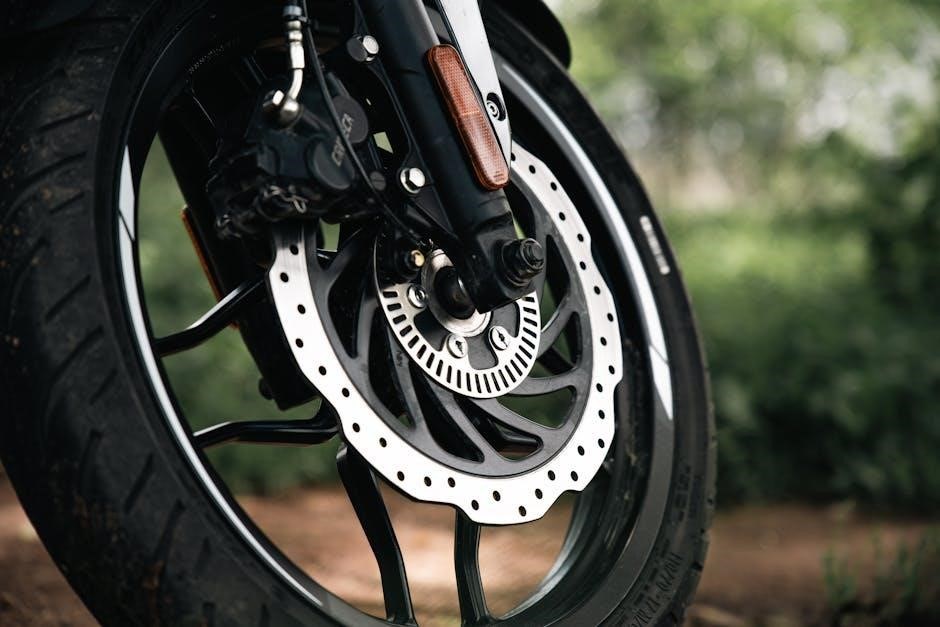Bike sizing is the process of matching a bike’s dimensions to a rider’s body measurements for optimal comfort, performance, and safety. Key measurements include height, inseam, reach, and stand-over height. Proper sizing ensures efficient pedaling, balanced handling, and reduced risk of discomfort or injury. While manufacturer size charts provide a starting point, factors like body proportions, riding style, and bike type (road, mountain, or hybrid) influence the ideal fit. Understanding these elements helps riders select the right bike for their needs, ensuring a enjoyable and safe cycling experience.
Why Proper Bike Sizing Matters
Proper bike sizing ensures comfort, performance, and safety. A well-fitted bike reduces the risk of discomfort, fatigue, and long-term health issues like back or neck pain. Incorrect sizing can lead to poor posture, inefficient pedaling, and reduced control, making cycling less enjoyable and potentially unsafe. Correct sizing optimizes ergonomics, allowing riders to maintain a neutral position and enjoy a more efficient, enjoyable, and injury-free cycling experience.
Understanding Stand-Over Height and Inseam
Stand-over height measures the clearance between the bike’s top tube and the rider’s inseam, ensuring safe dismounts and comfort. Inseam is the distance from the floor to the crotch, measured with shoes on. Proper stand-over height (1-2 inches less than inseam) prevents discomfort and injury. Accurate inseam and stand-over height are crucial for bike sizing, especially for mountain bikes, where clearance affects agility and safety during technical maneuvers.

Bike Sizing by Type
Bike sizing varies by type, with road bikes measured in centimeters, mountain bikes in inches, and hybrid/commuter bikes offering versatile sizing charts based on height and inseam.

Road Bike Sizing
Road bike sizing is based on frame size, measured in centimeters, from the bottom bracket to the top of the seat tube. Stand-over height and reach are critical for comfort. Proper sizing ensures efficient pedaling and handling. Riders should consider their inseam, height, and desired riding posture. Manufacturer size charts provide guidance, but precise fit may require adjustments. A well-fitted road bike enhances performance, reduces fatigue, and improves overall cycling efficiency and enjoyment.

Mountain Bike Sizing
Mountain bike sizing varies by brand, with sizes often listed in inches or as XS-XL. Wheel size (27.5″ or 29″) and stand-over height are key for clearance and control. Proper sizing ensures safety and agility, especially on technical terrain. While size charts guide selection, personal preferences for handling and comfort may influence the final choice. Always test ride if possible to confirm the best fit for your riding style and needs.
Hybrid and Commuter Bike Sizing
Hybrid and commuter bikes blend comfort and efficiency, with sizing based on height and inseam. Frames are measured in centimeters or inches, and wheel sizes vary to suit urban or mixed terrain. Proper sizing ensures a comfortable upright riding position, essential for commuting. Stand-over height and handlebar reach are critical for safe maneuverability. Always consult the manufacturer’s size chart and test ride to ensure the best fit for your daily commute or casual rides.

Frame Size Charts
Frame size charts help match riders to bikes based on height and inseam. Road bikes use centimeters, while mountain bikes use inches. These charts ensure proper fit and comfort.
How to Read a Bike Frame Size Chart
A bike frame size chart maps rider height and inseam to frame sizes. Road bikes use centimeters, while mountain bikes use inches. Match your height to the recommended size, considering inseam for stand-over clearance. Note that sizes vary by brand and bike type. Some charts include standardized sizes (XS-XL), while others list numeric or descriptive sizes. Always cross-reference with the manufacturer’s specific geometry chart for accuracy.
Sample Frame Size Chart for Different Bike Types
Here’s a sample frame size chart:
– Road Bikes: 47cm-63cm, corresponding to rider heights 5’0″-6’5″.
– Mountain Bikes: 13″-23″ (XS-XXL), suiting heights 4’11”-6’7″.
– Hybrid/Commuter Bikes: 14″-22″ or XS-XL, for heights 5’2″-6’4″.
– Kids’ Bikes: Wheel sizes 12″-24″, based on age and height.
This chart provides a general guide, ensuring a starting point for selecting the right bike type and size based on rider height and inseam measurements.

Key Measurements for Bike Sizing
Height, inseam, reach, and stand-over height are crucial for proper bike fit. These measurements ensure comfort, efficiency, and safety, guiding frame size selection across bike types.
How to Measure Your Height and Inseam

To measure your height, stand upright with feet flat and measure from the floor to the top of your head. For inseam, wear shoes and measure from the floor to the highest point of your inner leg at the crotch. This ensures proper stand-over clearance and pedal comfort. Use a flexible measuring tape or a book to mark the wall for accuracy. These measurements are crucial for selecting the right bike size.
Understanding Reach and Stack Measurements
Reach measures the horizontal distance from the saddle to the handlebars, affecting riding posture and comfort. Stack measures the vertical distance from the bottom bracket to the top of the handlebars, influencing how upright your position is. Proper reach avoids overextension, while optimal stack ensures comfort and visibility. These measurements vary by bike type and are key to achieving a balanced, efficient riding position, especially for road or mountain bikes where handling differs significantly.
Stand-Over Height and Clearance
Stand-over height is the distance between the bike’s top tube and your inseam when standing over the bike. Proper clearance ensures safety and comfort, preventing injuries during dismounts and providing control. Clearance should be 1-2 inches less than your inseam for optimal fit and maneuverability, especially for mountain bikes where agility is key. This measurement is crucial for both safety and performance, ensuring a comfortable riding experience.
Calculating Ideal Stand-Over Clearance
To calculate ideal stand-over clearance, measure your inseam and subtract the bike’s stand-over height. Aim for 1-2 inches of clearance for safety and comfort. This ensures easy dismounting and prevents injuries, especially during off-road riding. Proper clearance enhances control and maneuverability, making it a critical factor in bike sizing for all riders.
Why Clearance Matters for Safety and Comfort
Clearance, the space between the bike’s top tube and your inseam, is vital for safety and comfort. Adequate clearance ensures safe dismounts and prevents injuries. Insufficient clearance can lead to discomfort, loss of control, and potential harm. Proper clearance enhances riding posture, reduces strain, and improves overall cycling efficiency, making it essential for both casual and technical riders to prioritize when selecting a bike.
Bike Geometry Charts
Bike geometry charts detail a bike’s measurements, such as frame size, wheelbase, and angles, helping riders understand how components interact for optimal fit, performance, and comfort.
What to Look for in a Geometry Chart
A geometry chart provides detailed measurements of a bike’s frame, including stand-over height, reach, stack, wheelbase, head tube angle, seat tube angle, and chainstay length. These measurements help determine the bike’s handling, comfort, and fit. Look for data that matches your body proportions and riding style, ensuring proper fit and optimal performance for your specific cycling needs and preferences.
How to Use Geometry Charts for Sizing
Using a geometry chart for sizing involves comparing your body measurements to the bike’s specifications. Measure your height, inseam, and reach, then match these to the chart’s stand-over height, seat tube length, and handlebar reach. Ensure the bike’s stack and wheelbase align with your riding style. Cross-reference with your inseam for proper clearance and adjust frame size if needed. This ensures a precise fit, optimizing comfort and performance for your cycling preferences.
Adjusting Your Bike for the Perfect Fit
Adjusting your bike involves fine-tuning seat height, handlebar position, and other components to ensure comfort and control. Proper adjustments enhance performance and reduce discomfort during rides.
How to Adjust Seat Height and Handlebar Position
Adjusting seat height ensures proper leg extension and comfort. Stand beside the bike, place your heel on the pedal at the lowest position, and adjust the seat height until there’s a slight bend in your knee. For handlebars, ensure they are level with or slightly below the saddle. Move the handlebars up or down using spacers or by changing the stem height. Fine-tune the position by rotating the bars to match your riding posture for optimal comfort and control.
Tips for Fine-Tuning Your Bike Fit

Start with small adjustments to seat height, handlebar position, and tilt. Ensure the saddle is level and supports your sit bones. Experiment with handlebar height to maintain a neutral back and neck position. Use shoe cleats or orthopedic insoles for optimal pedal alignment. Regularly test adjustments on short rides to identify discomfort. Consider professional bike fitting for precision, especially for long-distance riding. Fine-tuning enhances comfort, efficiency, and overall cycling performance.

Frequently Asked Questions
Frequently Asked Questions about bike sizing address concerns like stand-over height, inseam measurements, and how different brands size their bikes, ensuring a proper fit for all riders easily.
What If I’m Between Sizes?
If you’re between sizes, consider your riding style, body proportions, and comfort preferences. For technical trails, smaller sizes offer better agility, while larger sizes suit faster, longer rides. Longer legs may require sizing up for stand-over clearance, and shorter arms might need sizing down. Test riding both sizes, if possible, or consult the manufacturer’s geometry chart for precise measurements. Your riding position preference—upright or aggressive—can also guide your decision. Ultimately, prioritize comfort and control for the best fit.
How Wheel Size Affects Bike Fit
Wheel size impacts bike fit by influencing stand-over height, clearance, and overall geometry. Smaller wheels lower the bike, improving agility for shorter riders, while larger wheels raise it, suiting taller riders. Mountain bikes often use 27.5″ or 29″ wheels, affecting frame size and fit. Ensure clearance matches your inseam for safety and comfort. Consider wheel size alongside frame size for optimal fit and riding performance.
